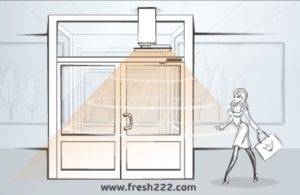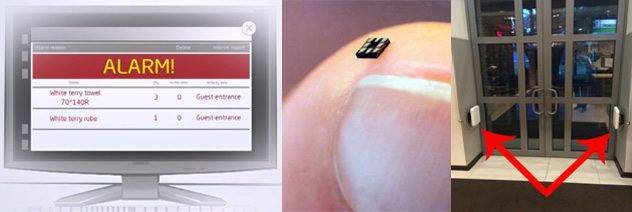The sphere of fitness club is beauty, health, sports in line with high-quality consumer services. Customers acquisition process encourages to launch new clients programs and service. But many owners forget about losses and do not even calculate them, but the more clients you have, the more losses you take. For you the latest anti-theft towel system.
Where do fitness clubs lose their cash?
As an example, the clubs owners constantly buy towels but towels always disappear without leaving a trace. And each month such a loss is converted into a reasonable amount of money that can be compared to sales of several dozens of membership cards.
Where do they disappear? The most frequent reason is when a club member accidentally puts a towel in a gym bag along with his belongings simply without noticing it or just in a hurry. And the towel is being carried out of a club by a customer and scarcely ever it’s been returned to a club facility again.
Anti-Theft Towels, Price and BuyWrite A Request
And a significant amount of club visitors and therefore a constant need of towels do not allow club employees to implement a thorough control and Anti-theft towels. How can this problem be solved?

A system to prevent the theft of towels, bathrobes and other textiles.
Anti-Theft Towel System, Price and Buy
It turns out that the solution is easy and simple, and what is more it’s not expensive at all. Recently anti-theft towel system has become more popular. This system is represented by antennas –readers that can be installed into walls or ceiling hidden from the sight, and by software and RFID tags embedded into towels. The trick is that RFID tags are invisible and practically not sensible, they are washable and they can resist high temperature and dry-cleaning and do not transform. All these qualities allow tags to stay unnoticeable for club members.
Therefore, if a club member on purpose or accidently will try to carry a towel out of a club, an alert signal will be activated even if a customer has just approached a club entrance, and an administrator will see a message on his computer screen that informs about a linen type, its unique ID number (e.g. a big white towel).
And it’s only one of the advantages that anti-theft towel system has.
Another one is that by using the same RFID tags, it’s possible to have a quick distant inventory, having in hand a portable RFID reader. The volume of textile products that are used in fitness clubs is significant and they can be located in different premises of a club facility. But a RFID reader scans up to 400 units per one second.
One more noteworthy advantage is that anti-theft towel system can be completed with a computerized towel locker. This locker automatically provides with a clean towel and has a compartment for used towels, important to notice- without engaging a housekeeping employee. RFID technologies always save your money.
How To Buy Anti Theft Towels Online
Anti Theft Towels

Towel theft might not seem like a big deal at first glance, but for businesses like hotels, gyms, and spas, it’s a costly and recurring issue. That’s where anti-theft towels come into play. These innovative towels are designed to prevent theft, save money, and streamline operations. In this article, we’ll dive into what anti-theft towels are, why they’re essential, and how they can be integrated into your business effectively.
Understanding Anti-Theft Towels
What Are Anti-Theft Towels?
Anti-theft towels are specially designed towels embedded with technology to deter theft. They often come equipped with RFID (Radio Frequency Identification) tags or other tracking mechanisms that allow businesses to monitor their movement and ensure they stay within designated areas.

Why Anti-Theft Towels Are Necessary
Towel theft leads to significant financial losses and operational disruptions. Anti-theft towels provide a practical solution to this problem, helping businesses maintain inventory levels, reduce costs, and improve overall efficiency.
The Impact of Towel Theft on Businesses
Financial Losses
Replacing stolen towels can be expensive, especially if they are high-quality, branded towels. Over time, these costs add up, impacting the business’s bottom line.
Operational Challenges
Towel theft complicates inventory management. Businesses must continuously track and reorder towels, leading to increased administrative workload and potential shortages.
Customer Trust and Experience
Customers expect clean and available towels at all times. Frequent shortages due to theft can lead to dissatisfaction, poor reviews, and loss of repeat business.
Conventional Methods of Preventing Towel Theft
Manual Counting
Manually counting towels at the end of the day is a common practice. While it helps track inventory, it’s labor-intensive and prone to human error.
Staff Supervision
Increasing staff presence in areas where towels are used can deter theft. However, this approach requires more labor and can make customers feel watched and uncomfortable.
Customer Awareness Programs
Educating customers about the impact of towel theft through signage or polite reminders can reduce incidents. However, its effectiveness varies and relies heavily on customer cooperation.
Technological Solutions for Anti-Theft Towels
RFID Technology
How RFID Works
RFID tags emit unique signals that can be tracked by RFID readers. When attached to towels, they allow businesses to monitor towel movement and detect unauthorized removals.
Benefits of RFID in Theft Prevention
RFID provides precise tracking, reducing the likelihood of theft. It also automates inventory management, minimizing manual effort and errors.
Barcode Systems
Barcode systems involve tagging towels with barcodes that are scanned at check-in and check-out points. This method is less expensive than RFID but requires manual scanning.
Embedded Security Features
Some anti-theft towels come with embedded security features like microchips or watermarks that are difficult to remove or alter, further deterring theft.
Implementing RFID Technology in Towels
Steps to Implement RFID Systems
- Assessment: Determine the specific needs of your business, including the scale of operation and budget.
- Planning: Design a layout for RFID readers and decide on the type of tags to use.
- Installation: Set up the RFID infrastructure, ensuring integration with existing systems.
- Testing: Conduct thorough testing to ensure everything works correctly before full deployment.
- Training: Train staff on how to use and manage the RFID system effectively.
Cost-Benefit Analysis
While RFID systems require a significant initial investment, the long-term savings from reduced theft and improved inventory management often outweigh the costs.
Case Studies of Successful Implementations
Many businesses have successfully implemented RFID systems. For instance, large hotel chains and fitness centers report significant reductions in towel theft and operational improvements.
Integrating Anti-Theft Towels with Inventory Management
Real-Time Tracking
RFID systems provide real-time data on towel usage and location, allowing businesses to monitor stock levels accurately and prevent shortages.
Automated Inventory Updates
RFID technology automates inventory updates, reducing the need for manual counting and minimizing errors.
Reporting and Analytics
Advanced RFID systems offer detailed reports and analytics, helping businesses understand usage patterns and make informed decisions about inventory management.
Advantages of Using Technology for Theft Prevention
Increased Accuracy
Technological solutions like RFID and barcodes offer higher accuracy in tracking and inventory management compared to manual methods.
Efficiency and Convenience
Automation saves time and labor, allowing staff to focus on more critical tasks and improving overall efficiency.
Scalability
These systems can easily scale to accommodate business growth, ensuring consistent theft prevention as operations expand.
Challenges and Considerations
Initial Investment
Setting up advanced anti-theft systems can be costly. Businesses need to consider the long-term benefits and potential savings when evaluating this investment.
Training Staff
Proper training is essential to ensure staff can effectively use and maintain new systems. This requires time and resources but is crucial for successful implementation.
Privacy Concerns
Implementing technology like RFID raises privacy issues. Businesses must ensure they comply with privacy laws and address customer concerns transparently.
Customer Perspective on Anti-Theft Towels
Enhancing Customer Trust
Transparent communication about anti-theft measures can enhance customer trust. Assuring customers that measures are in place to maintain quality and availability can improve their experience.
Customer Privacy
Balancing theft prevention with customer privacy is crucial. Ensure that data collected is used responsibly and that customers are informed about how their data is handled.
Educational Campaigns
Educating customers about the impact of towel theft and encouraging responsible behavior can reduce theft and foster a cooperative environment.
Future Trends in Anti-Theft Towels
AI and Machine Learning
AI can analyze usage patterns and detect anomalies, predicting and preventing theft before it happens.
Internet of Things (IoT)
IoT devices can enhance RFID systems, providing more detailed data and improving overall system functionality.
Predictive Analytics
Using data analytics to predict theft trends and adjust preventive measures proactively can further reduce losses.
Comparing Different Theft Prevention Systems
Cost Comparison
Evaluate the costs of various systems, including initial setup and ongoing maintenance, to determine the most cost-effective solution for your business.
Effectiveness
Assess the effectiveness of different systems based on case studies, industry reports, and vendor claims.
Ease of Implementation
Consider the complexity of implementing each system and choose one that aligns with your business’s capabilities and resources.
Choosing the Right Anti-Theft Towel System for Your Business
Assessing Your Needs
Identify the specific needs of your business, considering factors like scale, budget, and existing infrastructure.
Vendor Selection
Choose reputable vendors with proven track records in theft prevention technology. Evaluate their offerings based on features, support, and cost.
Implementation Strategy
Develop a comprehensive implementation strategy that includes planning, installation, testing, and training phases to ensure a smooth transition.
Maintenance and Upkeep of Anti-Theft Towel Systems
Regular Audits
Conduct regular audits to ensure the system is functioning correctly and to identify any issues early.
System Updates
Keep systems updated with the latest software and hardware improvements to maintain optimal performance.
Training Refresher Courses
Regularly update staff training to keep everyone informed about the latest features and best practices.
Conclusion
Towel theft, though seemingly minor, can have significant impacts on businesses. Anti-theft towels, particularly those equipped with RFID technology, offer a practical and efficient solution to this problem. By integrating these towels with inventory management systems, businesses can enjoy real-time tracking, automated updates, and detailed analytics. While the initial investment may be high, the long-term benefits make it worthwhile. Ultimately, choosing the right system, maintaining it properly, and educating both staff and customers are key to successful towel theft prevention.
FAQs
1. What are anti-theft towels and how do they work?
Anti-theft towels are specially designed towels embedded with technology, such as RFID tags, to prevent theft. They can be tracked in real-time, ensuring they stay within designated areas.
2. How effective are RFID systems in preventing towel theft?
RFID systems are highly effective due to their ability to provide real-time tracking and automated inventory updates, significantly reducing theft and operational inefficiencies.
3. What are the initial costs involved in setting up an anti-theft towel system?
Initial costs can vary widely based on the type of system and the scale of implementation. RFID systems tend to be more expensive initially but offer long-term savings.
4. How do anti-theft systems affect customer privacy?
It’s essential to balance theft prevention with customer privacy. Ensure that data collection is transparent, compliant with laws, and that customers are informed about its use.
5. Can small businesses benefit from high-tech anti-theft towel systems?
Yes, small businesses can benefit significantly from these systems as they help reduce losses, streamline operations, and improve inventory management, often outweighing the initial costs.




